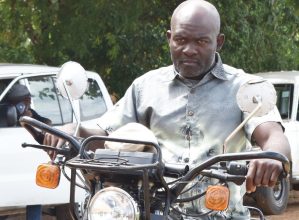EAM scales up disaster preparedness in Chikhwawa
For years, disaster management in the country meant responding with relief items after disasters strike. Today, the focus is on preparedness. How are people responding to this change? JOSEPHINE CHINELE and EPHRAIM NYONDO write.
The hovering dark clouds have, again, started to descend on Samson Village, Group Village Head Samson, Traditional Authority (T/A) Mulilima in Chikhwawa District. Heavy rains are imminent and floods are certain. But GVH Samson is not worried. He is just at ease.
“We have waited for long. Let the rains come, wet our fields so that our crops should grow,” he says, smiling.
But if this were two years ago, Samson could not even have afforded such a smile. He could have been anxious because rains, in his village, are key to the doors of floods.
In fact, for the 60 years she has been around, rainy season has hardly given her peace.
She has seen her maize crop washed away. She has shed a thousand tears watching her house melting in the sea of flooding waters. And she has, almost every rainy season, stood dumbfounded searching answers to convince her stranded people.
“I came to accept that flooding were part of us. I thought there could be no solution to this,” she says.
Actually, she is not the only Malawian who came to such a conclusion. There are many, not just those from Shire Valley but also those from flood-prone districts, for instance Salima and Mangochi, who cherished the belief that floods are larger than life—they should just be left to strike and then go.

Partly, such beliefs sprung from the way disasters were managed in the country before the signing of the Hyogo Framework of Action (HFA) in 2005.
Before HFA, disaster management meant responding with relief food and items after disasters strike. There were hardly attempts to manage the risks that cause disasters.
HFA, however, brought a paradigm shift—from disaster response to risk management, which is known as Disaster Risk Management (DRM).
Driven by this shift, development partners are pumping enormous resources both at national and local level to support DRM initiatives.
At the national level, the UNDP, working in collaboration with the Department of Disaster Management (Dodma), has been key in funding, among others, the development of DRM policy [which is yet to come to force], the DRM Handbook, the reviewing of the Disaster Management Act and also developing the DRM communication strategy.
At local level, a number of DRM activities are taking place. One of it is a disaster preparedness project which the Evangelical Association of Malawi (EAM) is implementing in Chikhwawa.
With funding from the Department of Preparedness Office (Dipecho), EAM, according to its regional manager James Kalikwembe, wants the communities to prepare for disasters through mastering early warning systems and also identifying and managing risks.
One of the first thing EAM did, he says, was to strengthen the already structures of Village Civil Protection Committees (VCPC).
“Specifically, the VCPCs were trained in best practices needed to prevent impact of floods on humanity and, again, best techniques of surviving them when they strike,” he says.
Mulilima is one of the VCPCs that received the training. Fraction Pemba is its chairperson.
“EAM came in and trained us in the best practices to prevent floods by building houses with strong foundation and planting trees along Likhubula River banks, among others,” he says.
Pemba adds that through the trainings in disaster preparedness, the communities have also learnt that floods occur in the area due to man-made problems such as wanton cutting of trees.
“Our area also experiences dry spell and strong winds at times. I believe this is the case because people destroyed trees through charcoal burning, hence, the rains are not so consistent that the river floods with water from upland districts,” he says.
Pemba also points out that a number of areas in Mulilima have, for years, been affected with floods because they lacked knowledge abou early warning signs.
“Today, we have rain gauges at a simple weather station constructed in the village and hydrometers along the river to measure water levels. The level of water recorded helps us to alert the people,” he says.
All VCPC members in Chikhwawa are provided with a mobile phone, megaphone and a bicycle to use when communicating impending danger.
Currently, EAM is constructing an evacuation centre along Chikhwawa-Nsanje Road—earmarked to host about 800 people in time of floods. It has two big rooms: one for women and the other for men. It also has toilets and bathrooms.
Graciano Malunga, a builder from Namila Village, T/A Mulilima says he went through a three month training In modern ways of building houses in flood prone-areas.
“I have so far built eight houses after the training. We were told to advise our clients accordingly, but others are already complaining that the modern protective design is expensive so they are still building the flood -prone type,” he says.
Kalikwembe, however, says that these local initiatives need to be effectively coordinated so that all flood-prone districts in the country are reached.
He expressed concern that the delay in finalising the DRM policy is posing a challenge in coordination these efforts. Currently, the policy is waiting to be taken to the Cabinet for scrutiny.
“The policy is vital for guidance and could still be used despite change in regimes. Even donors would want to see a policy first before trusting you with their money,” says Kalikwembe.
Though the policy is yet to be finalised, Samson, however, in Chikhwawa has all reason to smile even when the rains and floods are imminent. Her village is well prepared for disasters.





